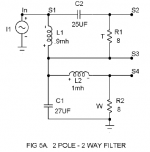Ben way to go. I've heard the 180 in SissySit, but it didn't match the detail of other p/p amps (real F7, clone F5). I have a pair in reserve. I too prefer SE topos, going for the natural. I think the whole attraction is getting the tube level detail with the balanced top to bottom. Bigger parts offer the power but at which expense (properly mated). For this reason I think of SE with a front end tailored to its need, and here I think of Generg liking J2 with Mos front end, cranked up.
Twitchie, hunt for the 1000W parts, 2SK182(non ES) and 2SK183H, still lurk below the radar and relatively cheap.
do you have any source for this?
I made some measurements with a 1kHz signal and measured the output Vrms with a multimeter. One measurement was with Rload of 220R and the other with 220R paralleled with 8.2R for 7.9R.
Rload = 220R Vrms out = 5.14V
Rload = 7.9R Vrms out = 2.74V
Output Impedance Zo = (R1 - R1 x V1/V2)/(V1/V2 - R1/R2) = ((220R - 220R x 5.14V/2.74V)/(5.14V/2.74V - 220R/7.9R) = 7.4R
I don't know how accurate this is. I was too lazy to pull out my old analogue oscilloscope to measure the output voltage.
Quite high output impedance, although not as high as resistor or light bulb loaded L'Amps, which I understand can be in the tens of Ohms. I have also read that the FW SIT-1 and SIT-2 have output impedance of 4 Ohm.
My speakers are very sensitive and also have a very benign impedance curve so the high output impedance is not a big issue for me.
Rload = 220R Vrms out = 5.14V
Rload = 7.9R Vrms out = 2.74V
Output Impedance Zo = (R1 - R1 x V1/V2)/(V1/V2 - R1/R2) = ((220R - 220R x 5.14V/2.74V)/(5.14V/2.74V - 220R/7.9R) = 7.4R
I don't know how accurate this is. I was too lazy to pull out my old analogue oscilloscope to measure the output voltage.
Quite high output impedance, although not as high as resistor or light bulb loaded L'Amps, which I understand can be in the tens of Ohms. I have also read that the FW SIT-1 and SIT-2 have output impedance of 4 Ohm.
My speakers are very sensitive and also have a very benign impedance curve so the high output impedance is not a big issue for me.
Thanks that brings up a question. Nelson has discussed that the crossover used with a current source amp is totally different than that used with a voltage source amp. So with an output impedance of 7.4 which would you use. That is would we call this a current source amp or a voltage source amp ? Or could I just use the voltage source crossover design without serious error till I build an active xover. Or with a current source crossover like in the figure.
Attachments
Well, this amp is not constant current source loaded. However choke loading does offer high impedance although not as high as a constant current source. The output impedance of 7.4R is high but not as high as the First Watt F1 at 80R or F2 at 15R.
FIRST WATT
I don't know enough to give you an answer. Hopefully someone more knowledgeable will answer your question.
FIRST WATT
I don't know enough to give you an answer. Hopefully someone more knowledgeable will answer your question.
Hi Soundhappy,
Thanks for your comments.
Yes, my preamp, a 2SK82 Luminaria, has low output impedance so frequency response is not an issue. I was writing something about that and you will see it soon.
I do enjoy the generous power of the Tokins, as I also have Tokin THF-51S SE BAF2015 monoblocks also.
Thanks for your comments.
Yes, my preamp, a 2SK82 Luminaria, has low output impedance so frequency response is not an issue. I was writing something about that and you will see it soon.
I do enjoy the generous power of the Tokins, as I also have Tokin THF-51S SE BAF2015 monoblocks also.
Buffer or No Buffer? PCB or Point to Point?
Buffer or No Buffer?
One characteristic of the Tokin SITs is their high input capacitance. According to spec sheets, it is 2500pF for both the 2SK180 and 2SK182ES, and 5000pF for the THF-51S.
This is a potential problem, depending on the output impedance of the source that connects directly to the amplifier, as the output impedance in conjunction with the Tokin device input impedance form a first order low pass filter. In the case of the 2SK180, a source output impedance of about 150 Ohm will produce a flat frequency output to approximately 20kHz, and then be 2dB down at about 55kHz.
So if a preamp or source that connects directly to a 2SK180 amplifier stage has an output impedance of 150 Ohms or less, there is no audible high frequency roll-off. If the output impedance is only a bit higher than 150 Ohms, perhaps the listener can tolerate a bit of roll-off. And as the output impedance of the connected source increases, the high frequency roll-off point becomes lower and lower.
The solution to the problem is to add an input buffer to the amplifier.
My preamp, the Luminaria, has an output impedance of about 75 Ohms, so high frequency roll-off is not an issue. No input buffer is included in my build.
For those needing an input buffer, or just want one so that any preamp or source can be connected without any worries of high frequency roll-off, there are many buffer designs to choose from. Since people here are Pass fans and this is a Pass forum, a logical choice would be a B1 or B1 R2, without the volume control. However with the scarcity and price of those JFETs, a very acceptable choice would be J113 jfets as implemented in the input of the B1 Korg preamp. I say, if it is good enough for the B1 Korg, it is good enough for the 2SK180 L'Amp. And it is readily available at a low cost.
I have included two LTSpice simulations- without buffer and with buffer to show the effects of a buffer and also to show the schematics of the buffer circuit. The simulation with buffer shows a source output impedance of 3K Ohm, and flat frequency output to nearly 30kHz, and 2dB down at about 90kHz, so the buffer does the job.
PCB or Point to Point?
As can be seen in my pictures, I wired everything point to point. The actual amplification circuit is very simple with very few parts. Most of the electonic circuits is the bias supply and V+ supply. Before I took up solid state amplification a few years ago, I built tube circuits with point to point wiring, so I am used to doing point to wiring.
For those of you who might want to try this amplifier design but prefer to build with printed circuit boards, I don't have any to offer.
But all is not lost. Zen Mod has a pcb that does it all. It has a bias power supply and input buffer all in one. Just connect a V+ power supply and Hammond 193V, transformer secondary for bias supply AC, a 2SK180, and output coupling cap, and that's it.
The Zen Mod Singing Bush Lower/Gain PCB:
The Singing Bush
Buffer or No Buffer?
One characteristic of the Tokin SITs is their high input capacitance. According to spec sheets, it is 2500pF for both the 2SK180 and 2SK182ES, and 5000pF for the THF-51S.
This is a potential problem, depending on the output impedance of the source that connects directly to the amplifier, as the output impedance in conjunction with the Tokin device input impedance form a first order low pass filter. In the case of the 2SK180, a source output impedance of about 150 Ohm will produce a flat frequency output to approximately 20kHz, and then be 2dB down at about 55kHz.
So if a preamp or source that connects directly to a 2SK180 amplifier stage has an output impedance of 150 Ohms or less, there is no audible high frequency roll-off. If the output impedance is only a bit higher than 150 Ohms, perhaps the listener can tolerate a bit of roll-off. And as the output impedance of the connected source increases, the high frequency roll-off point becomes lower and lower.
The solution to the problem is to add an input buffer to the amplifier.
My preamp, the Luminaria, has an output impedance of about 75 Ohms, so high frequency roll-off is not an issue. No input buffer is included in my build.
For those needing an input buffer, or just want one so that any preamp or source can be connected without any worries of high frequency roll-off, there are many buffer designs to choose from. Since people here are Pass fans and this is a Pass forum, a logical choice would be a B1 or B1 R2, without the volume control. However with the scarcity and price of those JFETs, a very acceptable choice would be J113 jfets as implemented in the input of the B1 Korg preamp. I say, if it is good enough for the B1 Korg, it is good enough for the 2SK180 L'Amp. And it is readily available at a low cost.
I have included two LTSpice simulations- without buffer and with buffer to show the effects of a buffer and also to show the schematics of the buffer circuit. The simulation with buffer shows a source output impedance of 3K Ohm, and flat frequency output to nearly 30kHz, and 2dB down at about 90kHz, so the buffer does the job.
PCB or Point to Point?
As can be seen in my pictures, I wired everything point to point. The actual amplification circuit is very simple with very few parts. Most of the electonic circuits is the bias supply and V+ supply. Before I took up solid state amplification a few years ago, I built tube circuits with point to point wiring, so I am used to doing point to wiring.
For those of you who might want to try this amplifier design but prefer to build with printed circuit boards, I don't have any to offer.
But all is not lost. Zen Mod has a pcb that does it all. It has a bias power supply and input buffer all in one. Just connect a V+ power supply and Hammond 193V, transformer secondary for bias supply AC, a 2SK180, and output coupling cap, and that's it.
The Zen Mod Singing Bush Lower/Gain PCB:
The Singing Bush
Attachments
-
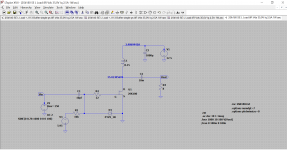 no input buffer150R impedance.png64.6 KB · Views: 1,063
no input buffer150R impedance.png64.6 KB · Views: 1,063 -
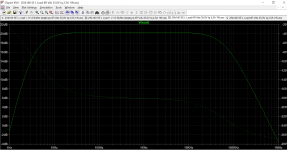 no input buffer 150R impedance freq response.png77.9 KB · Views: 1,078
no input buffer 150R impedance freq response.png77.9 KB · Views: 1,078 -
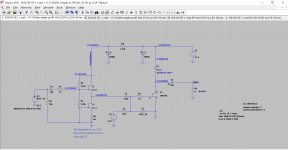 J113 input buffer3k impedance.png74.4 KB · Views: 1,052
J113 input buffer3k impedance.png74.4 KB · Views: 1,052 -
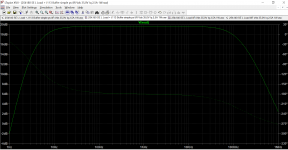 J113 input buffer 3k impedance freq response.png77.9 KB · Views: 1,043
J113 input buffer 3k impedance freq response.png77.9 KB · Views: 1,043 -
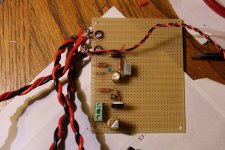 Point to Point Board - front.jpg630.4 KB · Views: 926
Point to Point Board - front.jpg630.4 KB · Views: 926 -
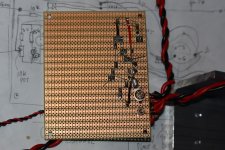 Point to Point board - back.jpg665.5 KB · Views: 433
Point to Point board - back.jpg665.5 KB · Views: 433
Peter,
If you have a B1 Korg, you're good to go. As you said, it has an output buffer, so its output impedance is low.
Ah.. answered already 😁
Okay BenMah
Thanks.
Peter,
I went into a bit more detail than just it worked with my Luminaria. Please re-read my post #31.
I should add that the LTSpice simulation of the amp without the input buffer had a source output impedance of 150R. A source such as the B1 Korg with J113 should still be fine with output impedance of 170R.
I went into a bit more detail than just it worked with my Luminaria. Please re-read my post #31.
I should add that the LTSpice simulation of the amp without the input buffer had a source output impedance of 150R. A source such as the B1 Korg with J113 should still be fine with output impedance of 170R.
Thanks, Greg.
It is difficult to say as far as the sound of increasing H3 as that happens at higher power output. Since my horn speakers have high sensitivity, the amplifier probably wouldn't go into the high power output region often. I also have neighbours that would not appreciate LOUD music.
I haven't listened to both channels at the same time yet as I have not completed the power supplies. I have the parts now so that will happen soon.
It is difficult to say as far as the sound of increasing H3 as that happens at higher power output. Since my horn speakers have high sensitivity, the amplifier probably wouldn't go into the high power output region often. I also have neighbours that would not appreciate LOUD music.
I haven't listened to both channels at the same time yet as I have not completed the power supplies. I have the parts now so that will happen soon.
Peter, I see what makes you worry. In case you think that a <=150 ohm output impedance is really needed, the 100 ohm output resistor of Korg B1 can be replaced with 82 ohm.... b1 korg has 140 to 170ohm output impedance...
- Home
- Amplifiers
- Pass Labs
- 25W Single Ended Hammond 193V Choke Loaded 2SK180 L'Amp
